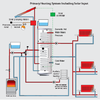Hi,
It's maybe time to upgrade our 21 yrs old vented CH/DHW system. It works fine and passes the emissions with flying colours, but when serviced recently the Scottish Gas guy (who has serviced it most of the last 11 years) showed me some paint scorching on the inside of the Ideal Classic boiler casing.
Don't want a combi so looking at a standard heat only boiler as a straight swap, but it'd be nice to have better DHW flow and maybe run a decent mixer shower from the system, so considering system boilers instead, since it seems they work from mains rather than a tank, thus giving mains pressure at DHW outlets (I understand this would also require a new cylinder). But I'm a bit confused to how a system boiler actually works.
Our existing boiler has only a flow and return at the boiler, and DHW is heated via a coil within the cylinder. How does a system boiler do it's thang? Is it the same but working from mains, or is there more to it?
And if we were to change to a system boiler (or other unvented system?) what might we need to consider? Our house is plumbed in Speedfit push fit fittings, would they be up to the job? And what about our 21 yr old rads? The taps and cisterns all have the baffle things removed so I assume would all need them fitted? And is my assumption correct that the cold taps would also be mains pressure?
Thanks for any help you guys could give, and/or feel free to suggest something better.
It's maybe time to upgrade our 21 yrs old vented CH/DHW system. It works fine and passes the emissions with flying colours, but when serviced recently the Scottish Gas guy (who has serviced it most of the last 11 years) showed me some paint scorching on the inside of the Ideal Classic boiler casing.
Don't want a combi so looking at a standard heat only boiler as a straight swap, but it'd be nice to have better DHW flow and maybe run a decent mixer shower from the system, so considering system boilers instead, since it seems they work from mains rather than a tank, thus giving mains pressure at DHW outlets (I understand this would also require a new cylinder). But I'm a bit confused to how a system boiler actually works.
Our existing boiler has only a flow and return at the boiler, and DHW is heated via a coil within the cylinder. How does a system boiler do it's thang? Is it the same but working from mains, or is there more to it?
And if we were to change to a system boiler (or other unvented system?) what might we need to consider? Our house is plumbed in Speedfit push fit fittings, would they be up to the job? And what about our 21 yr old rads? The taps and cisterns all have the baffle things removed so I assume would all need them fitted? And is my assumption correct that the cold taps would also be mains pressure?
Thanks for any help you guys could give, and/or feel free to suggest something better.


